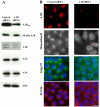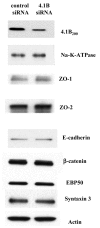A Golgi-associated protein 4.1B variant is required for assimilation of proteins in the membrane
- PMID: 19299464
- PMCID: PMC2714437
- DOI: 10.1242/jcs.039644
A Golgi-associated protein 4.1B variant is required for assimilation of proteins in the membrane
Erratum in
-
Correction: A Golgi-associated protein 4.1B variant is required for assimilation of proteins in the membrane (doi:10.1242/jcs.039644).J Cell Sci. 2019 Oct 21;132(20):jcs240002. doi: 10.1242/jcs.240002. J Cell Sci. 2019. PMID: 31636159 Free PMC article. No abstract available.
Expression of concern in
-
Expression of Concern: A Golgi-associated protein 4.1B variant is required for assimilation of proteins in the membrane (doi:10.1242/jcs.039644).J Cell Sci. 2019 May 2;132(9):jcs233080. doi: 10.1242/jcs.233080. J Cell Sci. 2019. PMID: 31048547 Free PMC article. No abstract available.
Abstract
The archetypal membrane skeleton is that of the erythrocyte, consisting predominantly of spectrin, actin, ankyrin R and protein 4.1R. The presence in the Golgi of a membrane skeleton with a similar structure has been inferred, based on the identification of Golgi-associated spectrin and ankyrin. It has long been assumed that a Golgi-specific protein 4.1 must also exist, but it has not previously been found. We demonstrate here that a hitherto unknown form of protein 4.1, a 200 kDa 4.1B, is associated with the Golgi of Madin-Darby canine kidney (MDCK) and human bronchial epithelial (HBE) cells. This 4.1B variant behaves like a Golgi marker after treatment with Brefeldin A and during mitosis. Depletion of the protein in HBE cells by siRNA resulted in disruption of the Golgi structure and failure of Na(+)/K(+)-ATPase, ZO-1 and ZO-2 to migrate to the membrane. Thus, this newly identified Golgi-specific protein 4.1 appears to have an essential role in maintaining the structure of the Golgi and in assembly of a subset of membrane proteins.
Figures










Similar articles
-
Na,K-ATPase transport from endoplasmic reticulum to Golgi requires the Golgi spectrin-ankyrin G119 skeleton in Madin Darby canine kidney cells.Proc Natl Acad Sci U S A. 1997 Sep 30;94(20):10711-6. doi: 10.1073/pnas.94.20.10711. Proc Natl Acad Sci U S A. 1997. PMID: 9380700 Free PMC article.
-
Ankyrin links fodrin to the alpha subunit of Na,K-ATPase in Madin-Darby canine kidney cells and in intact renal tubule cells.J Cell Biol. 1989 Feb;108(2):455-65. doi: 10.1083/jcb.108.2.455. J Cell Biol. 1989. PMID: 2537316 Free PMC article.
-
Golgi membrane skeleton: identification, localization and oligomerization of a 195 kDa ankyrin isoform associated with the Golgi complex.J Cell Sci. 1997 May;110 ( Pt 10):1239-49. doi: 10.1242/jcs.110.10.1239. J Cell Sci. 1997. PMID: 9191047
-
A spectrin membrane skeleton of the Golgi complex.Biochim Biophys Acta. 1998 Aug 14;1404(1-2):153-60. doi: 10.1016/s0167-4889(98)00054-8. Biochim Biophys Acta. 1998. PMID: 9714784 Review.
-
Regulation of epithelial cell polarity: a view from the cell surface.Cold Spring Harb Symp Quant Biol. 1992;57:621-30. doi: 10.1101/sqb.1992.057.01.068. Cold Spring Harb Symp Quant Biol. 1992. PMID: 1339699 Review. No abstract available.
Cited by
-
Crumbs organizes the transport machinery by regulating apical levels of PI(4,5)P2 in Drosophila.Elife. 2019 Nov 7;8:e50900. doi: 10.7554/eLife.50900. Elife. 2019. PMID: 31697234 Free PMC article.
-
Protein 4.1R regulates cell adhesion, spreading, migration and motility of mouse keratinocytes by modulating surface expression of beta1 integrin.J Cell Sci. 2011 Jul 15;124(Pt 14):2478-87. doi: 10.1242/jcs.078170. Epub 2011 Jun 21. J Cell Sci. 2011. PMID: 21693581 Free PMC article.
-
The spectrin-ankyrin-4.1-adducin membrane skeleton: adapting eukaryotic cells to the demands of animal life.Protoplasma. 2010 Aug;244(1-4):99-131. doi: 10.1007/s00709-010-0181-1. Epub 2010 Jul 29. Protoplasma. 2010. PMID: 20668894 Review.
-
Organization of myelinated axons by Caspr and Caspr2 requires the cytoskeletal adapter protein 4.1B.J Neurosci. 2010 Feb 17;30(7):2480-9. doi: 10.1523/JNEUROSCI.5225-09.2010. J Neurosci. 2010. PMID: 20164332 Free PMC article.
-
The 4.1B cytoskeletal protein regulates the domain organization and sheath thickness of myelinated axons.Glia. 2013 Feb;61(2):240-53. doi: 10.1002/glia.22430. Epub 2012 Oct 26. Glia. 2013. PMID: 23109359 Free PMC article.
References
-
- Aunis, D. and Bader, M. F. (1988). The cytoskeleton as a barrier to exocytosis in secretory cells. J. Exp. Biol. 139, 253-266. - PubMed
-
- Baines, A. J. and Bennett, V. (1985). Synapsin I is a spectrin-binding protein immunologically related to erythrocyte protein 4.1. Nature 315, 410-413. - PubMed
-
- Barr, F. A. and Short, B. (2003). Golgins in the structure and dynamics of the Golgi apparatus. Curr. Opin. Cell Biol. 15, 405-413. - PubMed
-
- Beck, K. A. (2005). Spectrins and the Golgi. Biochim. Biophys. Acta 1744, 374-382. - PubMed
Publication types
MeSH terms
Substances
Grants and funding
LinkOut - more resources
Full Text Sources

